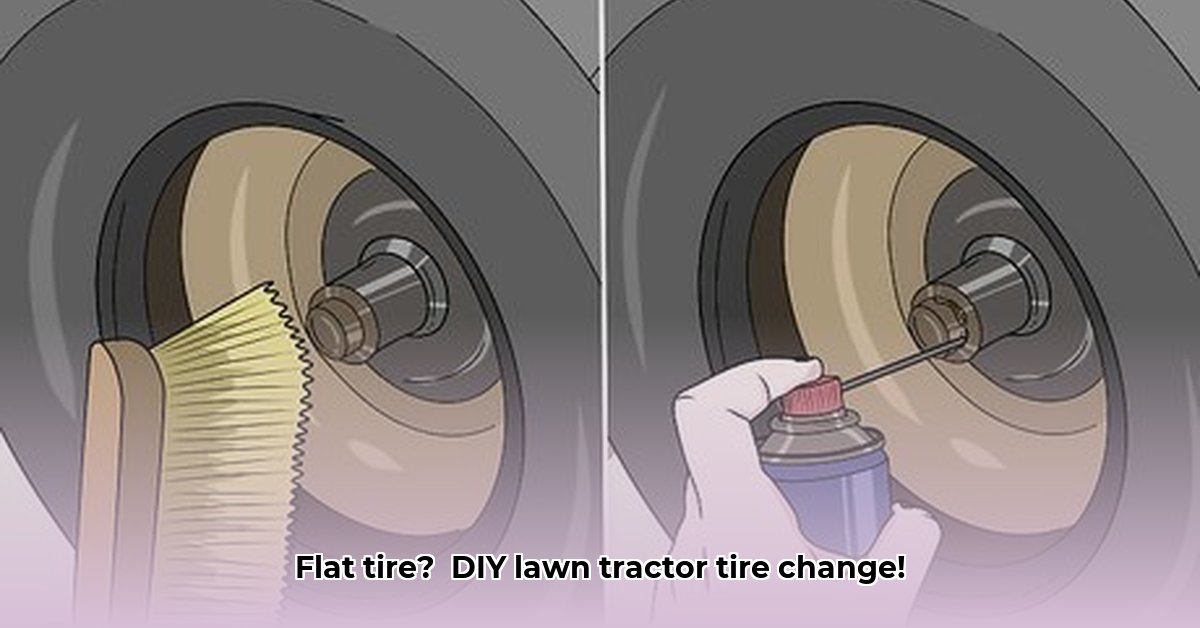
Changing a flat tire on your lawn tractor can seem intimidating, but with the right tools and techniques, it's a manageable DIY project. This guide provides step-by-step instructions for both on-rim and off-rim tire removal, emphasizing safety throughout the process. Whether you're a seasoned DIYer or a first-timer, this guide will empower you to tackle this common lawn care challenge. For more information on lawn tractor tires and tubes, check out this helpful resource: Lawn Tractor Tires.
Safety First: Your Well-being Matters Most
Before you begin, prioritize safety. This isn't optional; it's paramount. Failing to take proper precautions could lead to serious injury.
- Essential Protective Gear: Always wear sturdy work gloves to protect your hands, safety glasses to shield your eyes from flying debris, and closed-toe shoes to protect your feet.
- Secure the Tractor: Engage the parking brake firmly. Use wheel chocks to prevent any accidental rolling.
- Stable Support: Use a jack rated for your tractor's weight, but never work under a tractor supported only by a jack. Always use jack stands to provide a stable and secure platform. This is critical for your safety and prevents potential injury from a falling tractor. Don't skip this step!
Tools & Materials: Gathering Your Equipment
Having the right tools makes the job easier and safer. This checklist includes essential items, but always consult your tractor's owner's manual for model-specific requirements.
- Jack: Rated for your tractor's weight. (A jack with a capacity significantly higher than your tractor's weight ensures safety and stability.)
- Jack Stands: These are absolutely essential for safety, providing a secure platform to support your tractor. (Never work under a tractor supported only by a jack.)
- Lug Wrench: The correct size for your tractor's lug nuts. (A properly fitting wrench makes loosening and tightening much easier.)
- Penetrating Oil (e.g., PB Blaster): Helps loosen corroded or stuck lug nuts. (Apply generously and allow time to penetrate.)
- Tire Levers or Irons (for off-rim removal): These specialized tools help pry the tire off the rim without causing damage. (Use these carefully to avoid damaging the tire or rim.)
- Gloves, Safety Glasses: Remember, safety first! (Protect your eyes and hands from potential hazards).
A torque wrench is highly recommended to ensure lug nuts are tightened to the manufacturer's specifications, preventing future problems.
On-Rim Removal: Fixing a Flat While Keeping the Rim
This method is suitable for patching or replacing an inner tube.
- Preparation: Secure the tractor using wheel chocks and the parking brake. Raise the tractor with the jack and immediately place jack stands for secure support.
- Loosen Lug Nuts: Apply penetrating oil to the lug nuts, wait a few minutes, then carefully loosen them using the lug wrench. If they're extremely stuck, a gentle tap with a hammer on the wrench can help.
- Remove the Wheel: Once the tractor is securely supported by jack stands, completely remove the lug nuts and carefully take off the wheel.
Off-Rim Removal: Replacing the Tire or Rim
This process is necessary if you're replacing the tire, rim, or both.
- Preparation: Secure the tractor as outlined in the on-rim removal section.
- Breaking the Bead: Use tire levers or irons to carefully break the tire bead from the rim. Work methodically and evenly around the tire, using soapy water to lubricate the bead for easier removal. This requires patience and even pressure to avoid damage.
- Remove the Tire: Once the bead is broken, carefully work the tire off the rim, using tire levers as needed for assistance.
- Valve Stem Removal (If Necessary): If replacing the inner tube, remove the valve stem.
Post-Removal Inspection: A Crucial Step
Before installing a new tire, thoroughly inspect both the tire and the rim. Look for punctures, embedded objects, excessive wear, bulges, cracks, or rust on the rim. Identifying the problem's root cause helps prevent future issues.
| Tire Issues | Rim Issues |
|---|---|
| Punctures | Cracks |
| Excessive Wear & Tear | Bends |
| Bulges (sidewalls) | Rust |
| Cracked Sidewalls | Significant Scratches |
Responsible Disposal: Protecting the Environment
Dispose of your old tire and rim responsibly. Check your local waste disposal regulations or contact a local tire shop—many offer tire recycling programs. Environmental stewardship is everyone's responsibility.
Conclusion: Back to Mowing in No Time!
Following these steps carefully and prioritizing safety will ensure a successful tire change. Remember, if you're uncomfortable with any part of this process, seek professional assistance. A small investment in professional help is far less costly than potential injury or damage to your equipment. Now, get back to enjoying a perfectly manicured lawn!